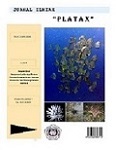Granulometric and Bioindex Analysis of Macrobenthos in Malalayang Coastal Waters
DOI:
https://doi.org/10.35800/jip.v10i1.38817Keywords:
intertidal, macrobenthos, sedimentAbstract
Â
The purpose of this study was (1) to describe macrozoobenthos and calculate and analyze bio-indexes including density, diversity, domination, and proprietary macrozoobenthos genus found on the beach of Malalayang. (2) inform the condition of habitat sediment granulometry and related to various macrozoobenthos bio-indexes found on the Malalayang Beach. The results of the identification of macrozoobenthos types obtained from the entire research station have obtained macrozoobenthos taxa covering 3 classes, namely: Gastropoda classes include 5 genera, namely Melanella, Margarites, Frigidoalvania, Oenopot, and Cylichna, Crustacean class (2 genera: Pagurus and Hemigrapsus) and Polychaeta classes ( 1 genus: nais). Macrozoobenthos density at Station 1 and Station 3. Overall, station 1 has the highest average density of 29.33 ind./m2; Furthermore, Station 3 has an average density of 23 indv. /m2; And finally Station 2 with a density of 17.67 Ind. /m2. Based on the results of the test, it was concluded that none of the values of the macrozoobenthos diversity index at the research site showed that the H1 acceptance or can be said that the results of the t-test stated that all the recatient research tests were not significantly different meaning the diversity of the entire station tested had the same diversity. The dominance index also obtains values that indicate the condition of the lack of dominance from certain macrozoobenthos genera at the research location.
The volume index is obtained that the community is in a stable condition only found at Station 3, namely the rear graduation area in the Malalayang River estuary. Communities that are in depressed conditions are found in the graduation land of station 1 and station 3, as well as the rearstal land of station 2. Other areas obtained by the community are in unstable conditions
The sediment composition that looks for files to stations at the research site displays diverse conditions. In general, through the graph of the sediment composition produced, at station 1 can be said to have decreased grain size towards land. Physical at Station 2, on the contrary, experienced an increase in a more rough (gravel) sediment on the middle and rear land, and at station 3, the center of the center looks composed of sediments that have a rough size.
Keywords: intertidal; macrobenthos; sediment
Â
Abstrak
Tujuan penelitian ini adalah (1) Mendeskripsikan makrozoobenthos serta menghitung dan menganalisis bioindeks meliputi kepadatan, keanekaragaman, dominasi, dan kemerataan genus makrozoobenthos yang terdapat di Pantai Malalayang. (2) Menginformasikan kondisi granulometri sedimen habitat dan kaitannya dengan berbagai bioindeks makrozoobenthos yang terdapat di pantai Malalayang. Hasil identifikasi jenis-jenis makrozoobenthos yang diperoleh dari keseluruhan stasiun penelitian telah diperoleh taksa makrozoobenthos meliputi 3 kelas yaitu: Kelas Gastropoda meliputi 5 Genera yakni Melanella, Margarites, Frigidoalvania, Oenopotadan Cylichna, Kelas Crustacea (2 Genus: Pagurus dan Hemigrapsus) dan Kelas Polychaeta (1 Genus: Nais).
Kepadatan makrozoobenthos pada Stasiun 1 dan Stasiun 3, Secara keseluruhan, Stasiun 1 memiliki rata-rata kepadatan tertinggi yaitu sebesar 29,33 ind./m2; selanjutnya Stasiun 3 memiliki kepadatan rata-rata 23 ind./m2; dan terakhir Stasiun 2 dengan kepadatan 17,67 ind./m2.
Berdasarkan hasil uji_t diperoleh kesimpulan bahwa tidak ada satupun dari nilai indeks keanekaragaman makrozoobenthos pada lokasi penelitian menunjukkan terima H1 atau dapat dikatakan hasil uji-t menyatakan bawha semua satisun penelitian yang di uji tidak berbeda nyata artinya keanekaragaman seluruh stasiun yang diuji mempunyai keanekaragaman sama. Indeks Dominansi juga memperoleh nilai-nilai yang menunjukkan kondisi tidak adanya dominasi dari genus makrozoobenthos tertentu pada lokasi penelitian.
Indeks kemerataan diperoleh bahwa komunitas berada dalam kondisi stabil hanya terdapat pada Stasiun 3, yaitu area lahan gisik bagian belakang di muara Sungai Malalayang. Komunitas yang berada dalam kondisi tertekan, terdapat pada lahan gisik bagian depan Stasiun 1 dan Stasiun 3, serta lahan gisik bagian belakang Stasiun 2. Area lainnya diperoleh komunitas berada dalam kondisi yang labil
Komposisi sedimen yang menghampari gisik pada stasiun-stasiun di lokasi penelitian menampilkan kondisi yang beragam. Secara umum, melalui grafik komposisi sedimen yang dihasilkan, pada Stasiun 1 dapat dikatakan terjadi penurunan ukuran butir ke arah darat. Gisik pada Stasiun 2, sebaliknya mengalami peningkatan sedimen berukuran lebih kasar (kerikil) pada lahan bagian tengah dan belakang, dan pada Stasiun 3, gisik bagian tengah tampak tersusun oleh sedimen yang memiliki ukuran kasar.Â
Kata Kunci: intertidal; makrobenthos; sedimen
References
Brower J. E., Zar J. H., 1977 Field and laboratory method for general ecology. William C. Brown Company, Dubuque, Iowa, 273 pp.
Cummins K.W., 1975. Chapter VIII. Macroinvertebrates. dalam Whitton B. A. (ed.). River Ecology. Studies in Ecology.Vol. II. Blackwell Scient. Puhl. Oxford.
FAO, 1998. Species Identification Guide for Fisheries Purpuse. The Lliving Marine Resources of The Western Central Pacific. Volume 2. Cephalopods, Crustaceans, Holothurians and Sharks. Edited by Kent E. Carpenter. Department of Biological Sciences Old Dominion University Norfolk, Virginia, USA and Volker H. Niem. Marine Resources Service Species Identification and Data Programme FAO Fisheries Department.Rome,
Folk, R.L. and W.C. Ward, 1957. Brazos River Bar : A Study in The Significance of Grain Size Parameters. Journal of Sedimentary Petrology. (1) : 3 – 26.
Gardener, M. Statistics for Ecologist Using R and Excel. Data Collection, Exploration, Analysis and Presentation. Second Editon. www.dataanalysis.org.uk/Publication/S4E2e%20Support/exercise/Comparing%20shannon%20diversity.htm. Diunduh 25 Maret 2019. Jam 20:30 WITA
Krebs, C. J., 1989. Ecological Methodology. An imprint of Addison Wesley Longman, Inc. Menlo Park, California; Reading, Massachusetts; New York; Harlow, England;
Legendre, P. and L. Legendre, 2012. Numerical Ecology. Third Edition. Elsevier B.V. All rights reserved. Radarweg 29, PO Box 211, 1000 AE Amsterdam. The Nederlands. 990 hal.
Mann, K. H. 1982. Ecology of Coastal Water : System Approach. London : Blackwell Scientific Publisher.
Magurran, A.E., 1988. Ecological Diversity and Its Measurement. Princeton University. Mew Jersey. 93 hal.
Nybakken, J.W., 1992. Biologi Laut Suatu Pendekatan (Terjamahan) PT. Gramedia. Jakarta. 459 p.
Odum, E.P., 1971. Fundamentals of Ecology. W.B. Saunders Company, Philadelphia, USA.
Pennak R.W., 1989. Fresh-Water Invertebrates of the UnitedStates. Protozoa to Mollusca. Third Edition. John Wiley& Sons, Inc. New York.
Poole, R.W., 1974. An Introduction to Quantitative Ecology. McGraw-Hill Book Company, INC. New York, pp. 375 -397.
Putro, S.P., 2014. Metode Sampling Penelitian Makrobenthos Dan Aplikasinya. Yogyakarta. Graha Ilmu, 2014.
Rahayu, G., A., Damayanti, B., Dadan, H., dan Akhmat, R. (2016). Keanekaragaman dan Peranan Fungsional Serangga pada Area Reklamasi Pasca Tambang Batubara di Berau, Kalimantan Timur. Jurnal Entomologi Indonesia, 14(2), 97-106
Rampengan, R.M., 2010. Komposisi Ukuran Butir Sedimen Gisik di Sekitar Muata Sungai Malalayang, Manado. Pacific Journal. Januari 2010. Vol. 3(4): 690 – 692. ISSN 1907 – 9672
Sapsuha, I., R.M. Rampengan, E.T. Opa, H.W.K. Manengkey,W.E. Pelle, dan F.F. Tilaar, 2019. Kemiringan Lereng dan Granulometri Sedimen Gisik Tanjung Merah, Bitung Sulawesi Utara. Jurnal Pesisir dan Laut Tropis. 7(2) : 90 – 97.
Simboh, R., R.M. Rampengan, H.W.K. Manengkey, R. Djamaluddin, E.T. Opa, dan H.J. Sinyal, 2021. Granulometri Sedimen Gisik Sekitar Groin Kalasey. Jurnal Ilmiah Platax. 9(2): 234 – 246.
Bec Crew, 2017. Explainer: What are marine macrofauna?. 28 November 2017. https://www.utas.edu.au/news/2017/11/28/467-explainer-what-are-marine-macrofauna/. University of Tasmania. Diunduh Senin 24 Februari 2021 jam 9:00 WITA.
WoRMS (World Registes of Marine Species),2019. Marine Species.http://www.marinespecies.org/.
Downloads
Published
How to Cite
Issue
Section
License
COPYRIGHT
Authors who publish with this journal agree to the following terms:
Authors hold their copyright and grant this journal the privilege of first publication, with the work simultaneously licensed under a Creative Commons Attribution License that permits others to impart the work with an acknowledgment of the work's origin and initial publication by this journal.
Authors can enter into separate or additional contractual arrangements for the non-exclusive distribution of the journal's published version of the work (for example, post it to an institutional repository or publish it in a book), with an acknowledgment of its underlying publication in this journal.
Authors are permitted and encouraged to post their work online (for example, in institutional repositories or on their website) as it can lead to productive exchanges, as well as earlier and greater citation of the published work (See The Effect of Open Access).


















